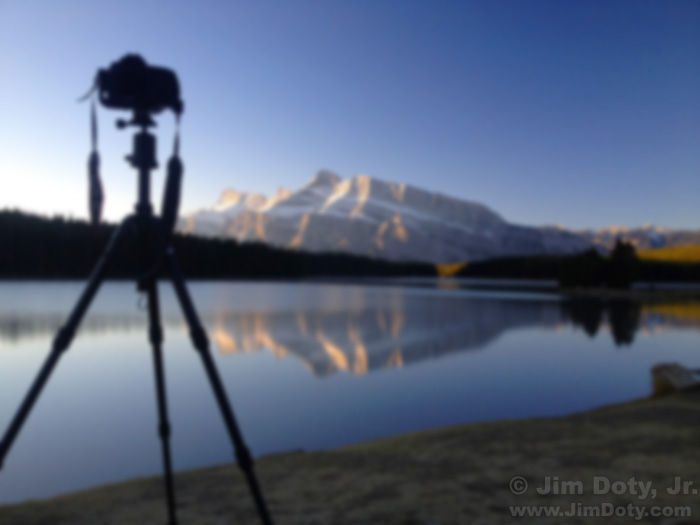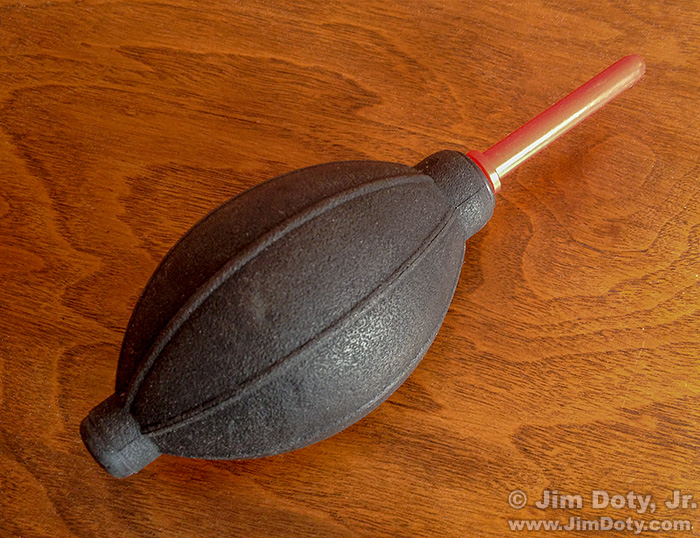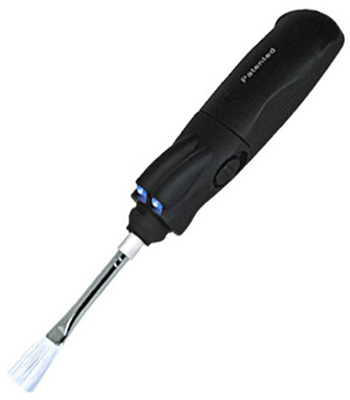Never, ever, never use compressed air to clean your camera. This is especially true of the mirror box and sensor. You can damage your camera. Today’s $160 cautionary tale comes from a friend of mine.
The call came in last night. A friend who lives across the country is having problems with her DSLR. She had a dark spot in the exact same place in all of her photos (a good sign of a speck on the sensor). A local camera store person blew the speck off the camera sensor. Now all of the photos from her camera are blurry. No matter how carefully she focuses the lens, and how sharp the photos look through the viewfinder, all of the photos come out uniformly blurred. That is very frustrating. Just look at the photo above and imagine all of your photos looking like that.
I said (suspecting the cause) “Please tell me they didn’t use a can of compressed air.”
“They did”, she replied.
The problem with using a can of compressed air is the risk of getting propellant on the sensor. It is like coating your sensor with an oily glaze. Your photos will all look uniformly blurred, much like having a thin coat of Vaseline on your camera lens. Theoretically, a very careful person will hold the can of air perfectly upright with the nozzle at the top (not at an angle), blow enough compressed air to clear the nozzle and tube, and then, without tilting the can at all, gently blow enough air into the mirror box to clean out the mirror box and sensor. BUT, you never know when some of the propellant will escape the can or tube and find its way onto your sensor. With a clear extension tube on the nozzle of a can of compressed air, I watched a 15 second blast of air fail to clear all the propellant from the tube. Sometimes you can get away with using compressed air, but why risk it?
As if that isn’t enough of a problem, the force of the compressed air can occasionally throw things in the mirror box out of alignment (like the mirror itself). The risk of misalignment gets higher as your camera gets older and parts begin to wear. Now you have really serious problems (i.e. expensive). I once saw a mirror fall right out of a DSLR (you see a lot of weird things if you teach photography). It is even more risky if you are using the force of an air compressor as opposed to using canned compressed air.
So my friend has propellant on her sensor and all her photos look blurry. They look sharp when she focuses because the mirror sends the image up to the viewfinder. The sensor in a DSLR isn’t involved in focusing unless you happen to have a camera that allows you to focus using “live view” mode. In live view mode the mirror and viewfinder aren’t involved. The mirror is up and out of the way and the sensor sends the image to the LCD on the back of the camera. My friend’s camera doesn’t have live view.
So the rule still holds true: Never, ever, never use compressed air to clean your camera! Some people use compressed air to clean the outside of their cameras, but I don’t want an oily film on the outside of my camera either. It holds dust like a magnet.
Update: April 22
Two days after I posted this article and a short version on Facebook, I received this comment on Facebook. Just one more example of the dangers of compressed air. The only good news in the midst of this bad news is he didn’t damage the sensor. That would have been way more expensive.
The way to clean your camera, including the mirror box, sensor, and the outside, is to use a bulb syringe. My favorite is the Giottos Rocket Air Blower. I keep one in my primary photo backpack. They cost about $12 alone or $20 in a kit. That is pretty cheap camera maintenance.
Sometimes you get a stubborn speck of dust that just won’t blow off the sensor. The next step up is a cleaning kit. I much prefer the ones from Visible Dust, and especially the Arctic Butterfly. A motor in the handle spins the brush to build up an electrical charge on the brush. Then you stop spinning the brush and gently stroke the camera sensor with the brush. The charge on the brush attracts dust particles. It’s a great idea. These wonderful tools sell for $70 – $130 depending on whether your DSLR has a full frame sensor or a smaller sensor with a field of view crop.
FYI: Canon 1D, 5D, and 6D series cameras have full frame sensors. Canon 7D, 70D, 60D, 50D (and so on), and all digital Rebel cameras have a smaller sensor with a 1.6X field of view crop. Nikon FX series cameras have a full fame sensor. Nikon DX cameras have a smaller sensor with a 1.5X field of view crop.
When you have an oily substance on your digital sensor, an air blower or an Arctic Butterfly won’t do the job. You need a cleaning kit with sensor swabs and cleaning fluid. (And you need the right size for your digital sensor.) My favorite kits are made by Visible Dust and the cost is about $27.
Put a couple of drops of fluid on a swab and wipe the sensor. Follow the directions that come with the kit very carefully. Repeat with more fluid on another swab. Keep this up until the sensor is clean. You need to be firm but not too firm. Propellant from a compressed air can is stubborn and by the time you wipe hard enough to get it off the sensor you run the risk of damaging the sensor. As you no doubt have guessed, it is expensive to replace the sensor.
One professional camera repair center charges $600 to $1600 to replace a digital sensor, depending on the model. The Nikon Service Center in New York quoted a repair price of about $1500 to replace the sensor in a Nikon D700. Why so much? Even if you just scratched the low pass filter on the front of the sensor, it is not unusual for the filter, sensor, and circuit board in the camera to be one unit so the whole unit needs to be replaced. Once the sensor is replaced it needs to be carefully calibrated with some high tech equipment.
Given the risks involved in cleaning propellant off the sensor (not to mention the costs for the kits) my friend isn’t ready to try cleaning her own sensor. Under the circumstances, I don’t blame her. The last time I checked, a CLA (clean lube and adjust) from an official camera manufacturer’s repair center will cost about $160 plus shipping. That is a lot less than replacing a scratched sensor from a botched home cleaning job.
I have the complete $200 deluxe kit from Visible Dust and I’ve cleaned my share of sensors but I’m not there to help clean my friend’s sensor. And I am a little bit leery of cleaning other people’s sensors. If I scratch one of my own sensors that is one thing, but I would feel terrible if I scratched someone else’s sensor. Just look at the sensor replacement prices below.
The really annoying part of this story is the person at the camera store. If they had used an air bulb blower instead of a can of compressed air, my friend’s camera would be just fine now. Instead, she is looking at a $160 repair job.
Links
Full frame sensors vs smaller sensors with a field of view crop
Arctic Butterfly 724 – for full frame DSLR sensors
Arctic Butterfly 707 – for smaller DLSR sensors
Visible Dust Sensor Cleaning Kit with Swabs and Fluid – for full frame DSLR sensors
Visible Dust Sensor Cleaning Kit with Swabs and Fluid – for smaller DSLR sensors
More Sensor Replacement Costs
There are more sensor replacement costs in this forum. Keep in mind that these are often discounted prices offered to professional photographers and businesses. Here are some of the sensor replacement prices quoted in this forum by RCicala:
Nikon D800e – $1866
Canon 5D Mark III – $762
Canon 7D – $396
Nikon D7000s – $500
“RCicala” in the above forum is Roger Cicala of LensRentals.com. If you need to rent a camera body, lens, or flash, Lens Rentals is the place to go.




